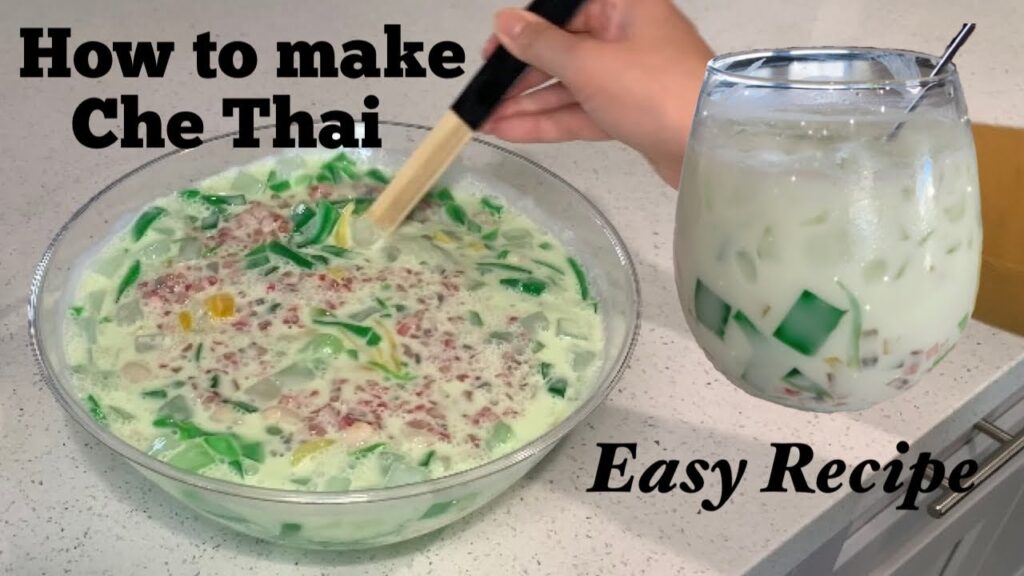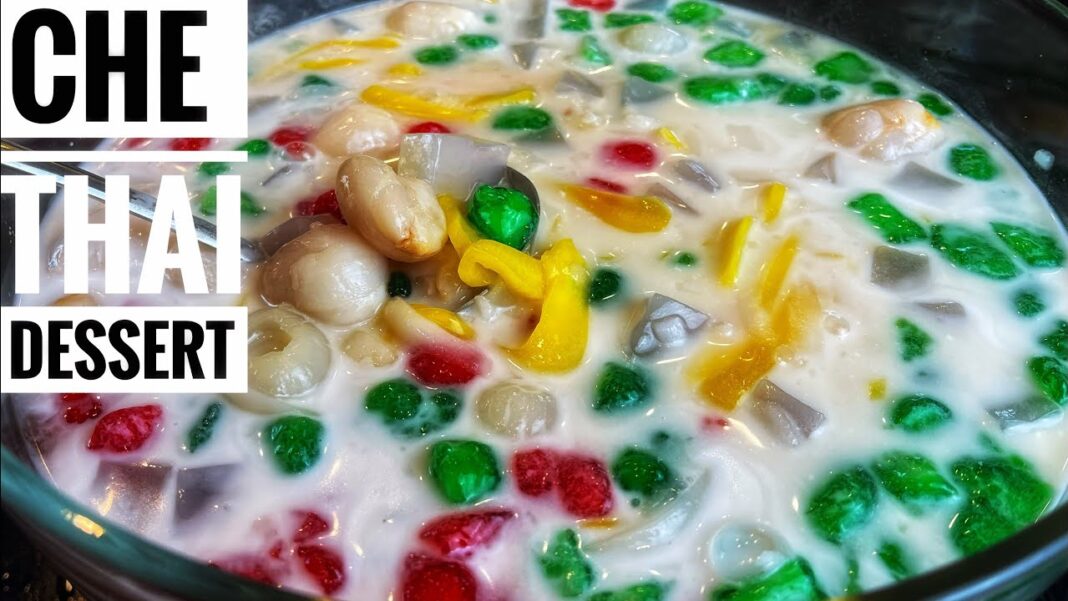What is Chè Thái?
Chè Thái is a vibrant and refreshing Vietnamese dessert known for its colorful appearance and delightful mix of textures and flavors. The name “Chè Thái” translates to “Thai sweet soup,” but it has become a beloved treat in Vietnam, blending the culinary influences of Thailand with local Vietnamese ingredients and tastes.
Origin and Cultural Significance
Chè Thái originated from the broader category of “chè” desserts in Vietnam, which encompasses a wide variety of sweet soups and puddings. Each type of chè has its unique ingredients and preparation methods, but Chè Thái stands out due to its use of tropical fruits, jellies, and sometimes even basil seeds or other unique elements. This dessert reflects the cultural exchange between Vietnam and its neighboring countries and has become a staple in Vietnamese celebrations and street food culture.
Popularity Around the World
With the rise of global interest in Asian cuisine, Chè Thái has garnered attention beyond Vietnam’s borders. Its popularity can be attributed to its visually appealing presentation, the refreshing taste that suits warm climates, and its adaptability to various dietary preferences. Food enthusiasts around the world enjoy making and consuming Chè Thái, often customizing it with local ingredients or personal twists.

Kitchen Equipment
Essential Tools Needed
To prepare Chè Thái, having the right kitchen tools is essential for efficiency and the best results. Here are the must-have items:
- Large Mixing Bowls: For mixing and holding various ingredients.
- Cutting Board and Sharp Knife: For chopping fruits and other components.
- Saucepan: To prepare syrups and cook tapioca pearls or jellies.
- Sieve or Strainer: To drain cooked ingredients like jellies or fruits.
- Measuring Cups and Spoons: For accurate ingredient measurement.
- Serving Glasses or Bowls: Traditionally, Chè Thái is served in clear glasses to showcase its colorful layers.
Optional Tools for Enhancements
While not strictly necessary, these tools can enhance your Chè Thái making experience:
- Ice Cream Scoop: For adding ice cream or scooping out ingredients.
- Mandoline Slicer: To achieve uniform slices of fruits or jellies.
- Blender: Useful for making smooth coconut milk or blending fruits.
- Decorative Serving Dishes: To elevate the presentation of your dessert.
Ingredients
Core Ingredients
Chè Thái requires a mix of fresh, canned, and sometimes dried ingredients. Here’s a breakdown of the essentials:
- Coconut Milk: The creamy base of the dessert.
- Tropical Fruits: Mango, lychee, jackfruit, and longan are commonly used.
- Red Rubies: Colored water chestnuts or tapioca pearls.
- Jellies: Agar-agar or grass jelly.
- Sweet Syrup: Usually made from sugar and water, sometimes flavored with pandan leaves.
Fresh vs. Canned Ingredients
The choice between fresh and canned ingredients can affect the texture and flavor of Chè Thái. Fresh fruits offer a vibrant taste and firm texture, while canned fruits are convenient and have a softer bite. Many traditional recipes balance the two to achieve a harmonious mix of flavors and ease of preparation.

Specialty Ingredients
Some recipes call for unique additions that can be sourced from Asian grocery stores:
- Pandan Leaves: For making syrup or adding aroma to the dessert.
- Basil Seeds: Often used for a fun, crunchy texture.
- Durian: A divisive but authentic addition for those who appreciate its strong flavor.
Substitutions and Additions
Common Substitutions
To accommodate dietary preferences or ingredient availability, consider these substitutions:
- Coconut Milk Alternatives: Almond milk or soy milk can be used for a lighter version.
- Fruit Substitutions: Pineapple, strawberries, or kiwi can replace traditional tropical fruits.
- Sugar Alternatives: Honey, agave syrup, or stevia for a healthier option.
Enhancing with Additional Ingredients
Add these ingredients to customize and enhance your Chè Thái:
- Ice Cream: Vanilla or coconut ice cream adds a creamy richness.
- Additional Jellies: Coffee jelly or lychee jelly for varied textures.
- Nuts and Seeds: Chopped peanuts or chia seeds for extra crunch.
What are Red Rubies and How to Make Them
Ingredients for Red Rubies
Red rubies are a popular addition to Vietnamese Fruit Cocktail, providing a delightfully chewy texture. You’ll need:
- Water Chestnuts: Fresh or canned.
- Red Food Coloring: For the signature red color.
- Tapioca Flour: To coat the water chestnuts.
Step-by-Step Guide to Making Red Rubies
- Prepare the Water Chestnuts: Dice water chestnuts into small cubes.
- Coloring: Mix the diced chestnuts with red food coloring until evenly coated.
- Coating: Toss the colored chestnuts in tapioca flour until fully coated.
- Cooking: Boil water in a saucepan, add the coated chestnuts, and cook until they float to the surface.
- Cooling: Transfer the cooked red rubies to a bowl of cold water to set their texture.

How to Make Vietnamese Fruit Cocktail
Preparation Steps
- Gather Ingredients: Ensure all ingredients are prepped and ready.
- Prepare Syrup: Boil water and sugar with pandan leaves to create a fragrant syrup.
- Cook Tapioca Pearls: If using, cook according to package instructions and set aside.
- Dice Fruits: Chop all fruits into bite-sized pieces.
Detailed Cooking Instructions
- Combine Ingredients: In a large mixing bowl, combine fruits, jellies, red rubies, and cooked tapioca pearls.
- Add Coconut Milk: Pour in the coconut milk, mixing gently.
- Sweeten: Add the prepared syrup to taste, ensuring the mixture is well-combined.
Assembly and Serving Tips
- Layering: For a beautiful presentation, layer the ingredients in clear serving glasses.
- Garnishing: Top with additional fruit slices or a scoop of ice cream.
- Serving: Serve chilled, with a spoon and straw for easy enjoyment.
Expert Tips
Tips for Perfect Texture
- Balancing Ingredients: Ensure a good mix of crunchy, chewy, and soft elements.
- Proper Cooking: Avoid overcooking tapioca pearls to maintain their chewiness.
Flavor Enhancements
- Aromatics: Infuse the syrup with pandan leaves or vanilla for added depth.
- Sweetness Control: Adjust the sweetness to your preference by varying the syrup amount.
Presentation Ideas
- Color Coordination: Use a variety of colored jellies and fruits for visual appeal.
- Elegant Glassware: Serve in tall, clear glasses to showcase the layers.
Storage Instructions
Short-term Storage
- Refrigeration: Store Vietnamese Fruit Cocktail in an airtight container in the fridge for up to 3 days.
- Serving: Stir well before serving to redistribute the ingredients.
Long-term Storage
- Freezing: Not recommended as the texture of fruits and jellies can be compromised.
Reheating Tips
- Cold Serving: Chè Thái is best served chilled. If it becomes too thick, add a bit more coconut milk before serving.
Health Benefits and Considerations
Nutritional Information
Chè Thái is a treat that, while indulgent, can offer some nutritional benefits:
- Vitamins and Minerals: From the variety of fruits used.
- Fiber: Contributed by fruits and jellies.
- Healthy Fats: Present in coconut milk.
Health Benefits
- Hydration: The high water content in fruits and jellies helps maintain hydration.
- Antioxidants: Found in many of the tropical fruits used.
Dietary Considerations
- Calories: Be mindful of the calorie content, especially if adding sweet syrups or ice cream.
- Allergies: Check for any potential allergens, especially with nuts or certain fruits.
Chè Thái is more than just a dessert; it’s a culinary experience that brings together a variety of flavors and textures into one delightful treat. Whether you’re a seasoned chef or a home cook, making Chè Thái can be a rewarding way to explore Vietnamese cuisine and share a refreshing dessert with loved ones. So, gather your ingredients and try making Chè Thái today—your taste buds will thank you!
FAQs about Chè Thái
What does Chè Thái taste like?
Chè Thái is a delightful mix of sweet, creamy, and fruity flavors with varied textures ranging from chewy tapioca pearls to crunchy water chestnuts.
Can Chè Thái be made vegan?
Yes, Chè Thái can easily be made vegan by ensuring all ingredients, including jellies and milk, are plant-based.
How long does Chè Thái last in the fridge?
Chè Thái can last up to 3 days in the refrigerator when stored properly in an airtight container.
Is Chè Thái gluten-free?
Typically, Chè Thái is gluten-free but always check ingredient labels, especially for jellies and tapioca pearls, to ensure they are gluten-free.
